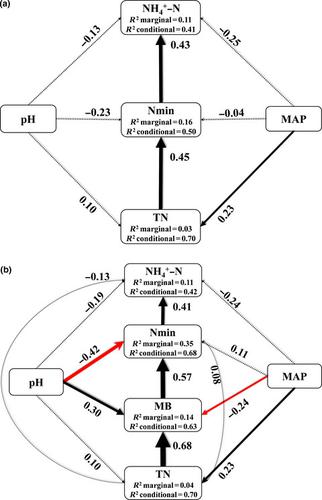当前位置:
X-MOL 学术
›
Glob. Change Biol.
›
论文详情
Our official English website, www.x-mol.net, welcomes your
feedback! (Note: you will need to create a separate account there.)
Microbes drive global soil nitrogen mineralization and availability
Global Change Biology ( IF 10.8 ) Pub Date : 2019-01-15 , DOI: 10.1111/gcb.14557 Zhaolei Li 1 , Dashuan Tian 1 , Bingxue Wang 1 , Jinsong Wang 1 , Song Wang 1, 2 , Han Y. H. Chen 3 , Xiaofeng Xu 4 , Changhui Wang 5 , Nianpeng He 1, 2 , Shuli Niu 1, 2
Global Change Biology ( IF 10.8 ) Pub Date : 2019-01-15 , DOI: 10.1111/gcb.14557 Zhaolei Li 1 , Dashuan Tian 1 , Bingxue Wang 1 , Jinsong Wang 1 , Song Wang 1, 2 , Han Y. H. Chen 3 , Xiaofeng Xu 4 , Changhui Wang 5 , Nianpeng He 1, 2 , Shuli Niu 1, 2
Affiliation

|
Soil net nitrogen mineralization rate (Nmin), which is critical for soil nitrogen availability and plant growth, is thought to be primarily controlled by climate and soil physical and/or chemical properties. However, the role of microbes on regulating soil Nmin has not been evaluated on the global scale. By compiling 1565 observational data points of potential net Nmin from 198 published studies across terrestrial ecosystems, we found that Nmin significantly increased with soil microbial biomass, total nitrogen, and mean annual precipitation, but decreased with soil pH. The variation of Nmin was ascribed predominantly to soil microbial biomass on global and biome scales. Mean annual precipitation, soil pH, and total soil nitrogen significantly influenced Nmin through soil microbes. The structural equation models (SEM) showed that soil substrates were the main factors controlling Nmin when microbial biomass was excluded. Microbe became the primary driver when it was included in SEM analysis. SEM with soil microbial biomass improved the Nmin prediction by 19% in comparison with that devoid of soil microbial biomass. The changes in Nmin contributed the most to global soil NH4+‐N variations in contrast to climate and soil properties. This study reveals the complex interactions of climate, soil properties, and microbes on Nmin and highlights the importance of soil microbial biomass in determining Nmin and nitrogen availability across the globe. The findings necessitate accurate representation of microbes in Earth system models to better predict nitrogen cycle under global change.
中文翻译:

微生物推动全球土壤氮矿化和可用性
土壤净氮矿化速率(N min)对土壤氮素的利用和植物的生长至关重要,据认为主要受气候和土壤物理和/或化学性质的控制。但是,尚未在全球范围内评估微生物在调节土壤N min方面的作用。通过从198个已发表的陆地生态系统研究中收集的1565个潜在净N min观测数据点,我们发现N min随着土壤微生物生物量,总氮和平均年降水量而显着增加,但随土壤pH值而降低。N min的变化在全球和生物群落尺度上,主要归因于土壤微生物生物量。平均年降水量,土壤pH值和土壤总氮通过土壤微生物显着影响N min。结构方程模型(SEM)表明,当排除微生物量时,土壤基质是控制N min的主要因素。当微生物被包括在SEM分析中时,它就成为主要驱动力。与不含土壤微生物量的SEM相比,含土壤微生物量的SEM将N min预测值提高了19%。N min的变化对全球土壤NH 4 +的贡献最大‐N与气候和土壤特性相反的变化。这项研究揭示了气候,土壤特性和微生物在N min上的复杂相互作用,并强调了土壤微生物生物量在确定N min和全球氮素利用率方面的重要性。这些发现需要在地球系统模型中准确表示微生物,才能更好地预测全球变化下的氮循环。
更新日期:2019-01-15
中文翻译:

微生物推动全球土壤氮矿化和可用性
土壤净氮矿化速率(N min)对土壤氮素的利用和植物的生长至关重要,据认为主要受气候和土壤物理和/或化学性质的控制。但是,尚未在全球范围内评估微生物在调节土壤N min方面的作用。通过从198个已发表的陆地生态系统研究中收集的1565个潜在净N min观测数据点,我们发现N min随着土壤微生物生物量,总氮和平均年降水量而显着增加,但随土壤pH值而降低。N min的变化在全球和生物群落尺度上,主要归因于土壤微生物生物量。平均年降水量,土壤pH值和土壤总氮通过土壤微生物显着影响N min。结构方程模型(SEM)表明,当排除微生物量时,土壤基质是控制N min的主要因素。当微生物被包括在SEM分析中时,它就成为主要驱动力。与不含土壤微生物量的SEM相比,含土壤微生物量的SEM将N min预测值提高了19%。N min的变化对全球土壤NH 4 +的贡献最大‐N与气候和土壤特性相反的变化。这项研究揭示了气候,土壤特性和微生物在N min上的复杂相互作用,并强调了土壤微生物生物量在确定N min和全球氮素利用率方面的重要性。这些发现需要在地球系统模型中准确表示微生物,才能更好地预测全球变化下的氮循环。


















































 京公网安备 11010802027423号
京公网安备 11010802027423号